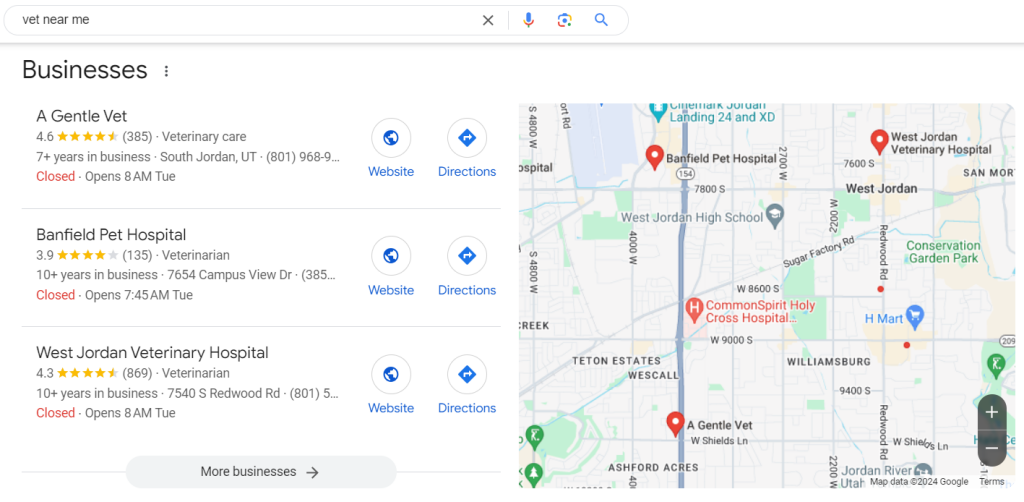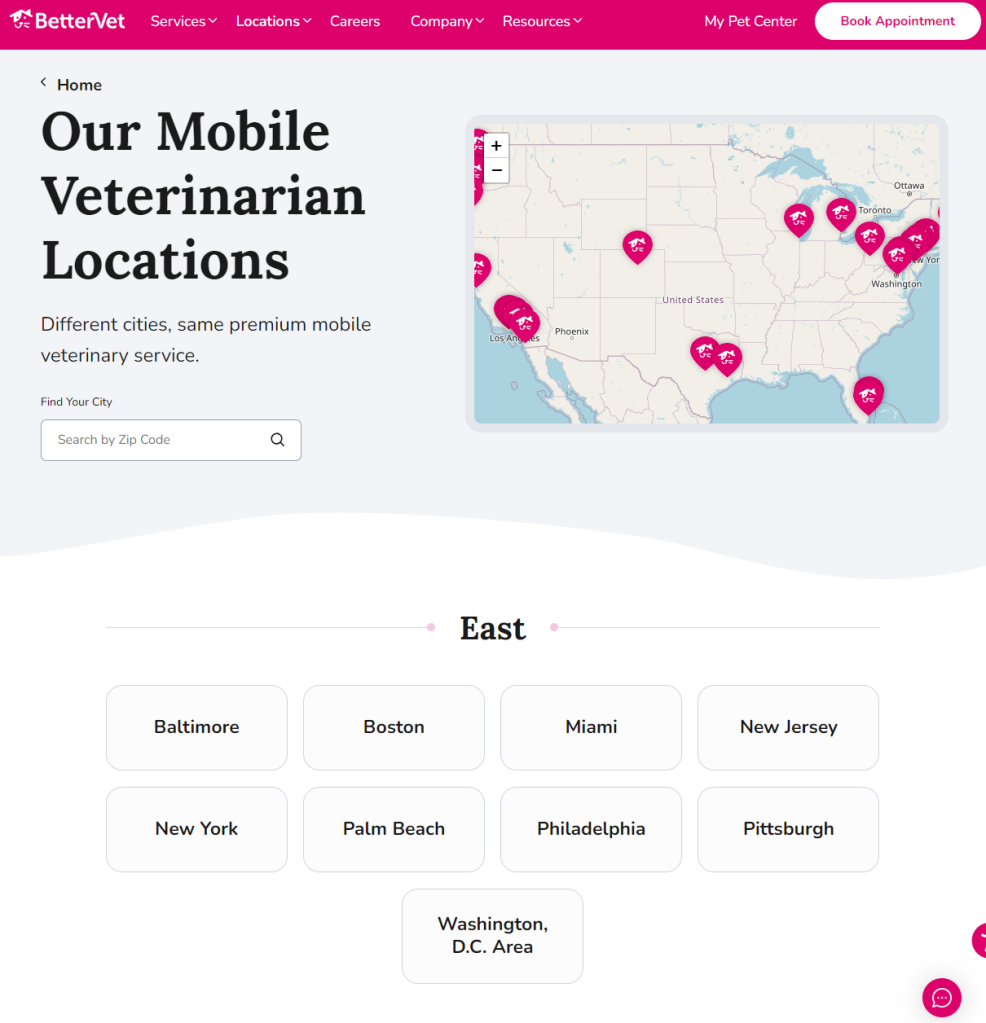
What is Local SEO?
Local search engine optimization (SEO) involves optimizing your website to show up in local search results like the map pack. It consists of various tactics to ensure your business ranks for local keyword searches. These tactics include optimizing your Google My Business profile, reputation management, on-page SEO, and local backlink building. These are important local SEO ranking factors, but proximity, prominence, and relevance are also primary driving local ranking factors for Google.
This local SEO guide will discuss some of these local SEO tactics, why local SEO is important, local SEO keyword modifiers, and more.
Why is Local SEO Important?
Local SEO is important because it helps improve the organic visibility of your website in local search results. This helps attract potential customers to make a purchase or visit your business location. If you compete on a national and a local level, it’s also an excellent opportunity to capitalize on a competitive advantage that you may have over national competitors.
The primary place where businesses compete for local search real estate is in the local map pack results.

The local map pack is important for the following reasons:
- Appears at the top of the SERP before the organic listings
- Dominates the screen on mobile devices
- Receives 42% CTR from local searches (according to a Backlinko study)
- Improve trust and reputation when you appear in the map pack because it shows that your business is relevant
- This can lead to increased foot traffic if you have a physical location
- Streamline directions to your business for your customers
- The local map pack usually appears for keywords with local modifiers (see below)
Overall, ranking in the local map pack and the organic listings below will make your business relevant to your customer base, resulting in more sales and revenue.
Local SEO Keyword Modifiers
Local SEO keyword modifiers should be considered when conducting keyword research for your business. These modifiers can fall into a few different categories.
Location Modifiers
- City or neighborhood name: e.g., “electrician in Denver,” “donut shop in Venice”
- State, Region, or Country: e.g., “dentists in Utah,” “cleaning services in Canada”
- Near Me or Close By: e.g., “gas station near me,” “car wash close by”
Service or Business Type Modifiers
- Service Location: e.g., “24/7 hour locksmith in Atlanta,” “cheap barber in Phoenix”
- Industry Terms: e.g., “vegetarian restaurant in New York City,” “computer repair services in Dallas”
Time Modifiers
- Open: e.g., “drug store open now,” “grocery store open near me”
- 24 Hour: e.g., “24 hour gym in Reno,” “24 hour tow in Austin”
Price and Quality Modifiers
- Cheap or Affordable: e.g., “cheap motels in Portland,” “affordable dog trainer near me”
- Best or Top Rated: e.g., “best Chinese restaurant in San Diego,” “top rated plumber near me”
- Luxury: e.g., “luxury townhomes in Seattle,” “high end sauna near me”
Key Components of a Successful Local SEO Strategy
Google My Business (GMB) Optimization

Google My Business (GBM) is the dedicated space Google provides local businesses to communicate with customers through local search results and Google Maps. Companies can provide information such as hours of operation, services offered, address, phone number, and website links. Ensure the following for proper GMB optimization:
- Accurate business information: Name, address, phone number, business category, and hours of operation
- Optimize business description with keywords and highlight value proposition
- Add photos and videos that are high-quality
- Utilize GMB posts that have calls to action
- Encourage reviews
- Respond to reviews
- Select relevant business attributes such as “wheelchair accessible” or “free Wi-Fi”
- List services
- Add FAQs
- Add relevant links to your website and social media profiles
- Update regularly
A well-optimized GMB conveys to customers that your business is legitimate and has a good reputation, making it more likely for them to choose your services or products over your competitors.
Local Citations
On review sites, social media profiles, and business listing directories, citations mention a business name, address, and phone number. Citations can improve local search results if they are consistent and accurate. For example, if you had a different address for your business on your website and your GMB profile, then this would negatively impact your SEO. Even nuances such as spelling out avenue vs abbreviating it to ave should be consistent. This consistency helps Google to rank legitimate businesses.
Citations can be built in a variety of ways:
- List your business on local directories
- Get listed on industry-specific directories
- Create social media profiles
- Submit your business information to data aggregators
Reviews
The number and quality of your reviews across all platforms significantly impact your local SEO
- Encourage customers to leave reviews by providing incentives like discounts.
- Reviews should be monitored and responded to — include keywords in the responses if possible to do so in a way that sounds natural
- Highlight reviews on your website
- Diversify review platforms
- Don’t submit fake reviews
By encouraging reviews, responding quickly and constructively, and maintaining consistency across platforms, businesses can build trust, increase visibility, and attract more local customers.
On-Page SEO
On-page SEO includes all the elements on your website pages that impact local search engine results.
- H1, meta title, and meta description should be keyword-optimized
- Proper use and order for all headings H1 → H2 → H3, etc.
- Content should satisfy user search intent
- Content keywords optimized with primary keywords, secondary variations, and semantically related keywords — keywords should only be included if they can be integrated into the content in a way that sounds natural
- URL keyword optimized
Ensuring these foundational on-page SEO elements are taken care of is essential to having local SEO success.
Technical SEO
Technical SEO ensures that Google can adequately crawl, index, render, and rank your content. Consider the following to have sound technical SEO:
- Website load speed optimized
- Resolve indexation errors
- Optimize site structure
- Utilize internal linking to demonstrate relevance between pages
- Utilize schema markup types like LocalBusiness schema
- Ensure all content is rendered correctly
There are many technical SEO factors, and these are just a few. They should be monitored regularly by performing site crawls with SEO tools like Screaming Frog.
Building Local Backlinks
In Google’s eyes, backlinks are viewed as votes of trust and authority. For local SEO, getting votes of trust from other organizations in your location will carry more weight for the local SERPs. Consider the following to build local backlinks:
- Partner with other local businesses
- Work with a local charity
- Engage with local media
- Engage with community websites and forums
- Partner with a local social media influencer
- Participate in local events and sponsor some, if possible
Building backlinks from local sources will help improve your local search marketing strategy and enable you to network with others in your area, which is excellent for your business.
Measuring Local SEO Success
You will need to monitor some key performance indicators to effectively optimize your local SEO strategy.
- GMB insights such as clicks, views, and direction requests
- Local keyword rankings
- Organic traffic
- Conversions from organic traffic
There are a variety of tools that you can use to help you accurately keep track of your KPIs. You can use Google Analytics to keep track of organic traffic and conversion from organic traffic. There are some excellent local SEO keyword tracking tools that help you measure rankings granularly. One that I use regularly is called LocalFalcon.

Having this level of granularity with local keyword rankings will help you make better decisions regarding optimizing your various GMBs and local pages. These local scans can help inform you if a ranking might be impossible because of a lack of proximity.
KPIs should be utilized to determine the effectiveness of the local SEO strategies implemented. It’s important to experiment with new ideas and iterate on strategies over time to ensure your competitiveness in local SEO.
Local SEO With No Physical Location
Even if your business doesn’t have a physical location, it can still compete in local SEO. At Growth Skills, we helped one of our former clients, BetterVet, do exactly this by helping them implement several SEO strategies, one of which involved building out location pages to capture local SEO traffic.

A locations hub page was developed so that BetterVet’s cities of operation could be centrally located on the site.

The location pages were developed to rank for location modifier and service type modifier keywords. For example, the Austin location page ranks for the following keywords:
- Mobile vet Austin
- Ranks In Local Map Pack: Yes
- Search Volume: 880
- Modifier: Location
- Mobile euthanasia Austin
- Ranks In Local Map Pack: Yes
- Search Volume: 30
- Modifier: Service Type + Location
BetterVet wouldn’t rank for these types of keywords without the location pages.
These location pages are successful because they have been optimized to satisfy user search intent and convey Experience, Expertise, Authoritativeness, and Trustworthiness (EEAT). These pages include the following on-page SEO elements that contribute to their local SEO success:
- Keyword integration in H1, meta title, meta description, and content copy
- CTA to book appointments above the fold
- Awards are displayed above the fold to convey EEAT
- Content mentions that BetterVet’s Vets are “Fear Free Certified,” contributing to EEAT
- Location specific content
- All services are clearly displayed on the page
- Pricing is clearly displayed in a table, contributing to transparency and improving EEAT
- The Austin BetterVet vets have pictures on the page, and they link them to their bio pages, improving EEAT
- Reviews from Google are displayed on the page
- There’s a video on the page highlighting why customers should choose BetterVet
- A Map of Austin is embedded on the page
- The page links internally to other Texas city landing page
- FAQ section
- Options to communicate with BetterVet in Austin are displayed on the page: live chat, phone, and email
- NAP is consistent with GMB
- URL structure is optimized
- Fast page load speed

The metrics for the BetterVet Austin location page demonstrate how just one location page can expose over five hundred potential customers to BetterVet in one month.
Conclusion
Local SEO can be highly competitive, but it will pay dividends if done correctly. By optimizing key elements such as your GMB, building local backlinks, managing citations properly, and satisfying user search intent, you can improve your chances of ranking in the local map pack for relevant local keywords and drive more traffic to your website and revenue for your business. These efforts should be monitored and improved over time to ensure your local SEO strategy doesn’t stagnate.



